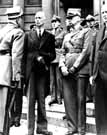
|
|
|

|

|

|

|
|
Click on an image to see a larger, more detailed picture.
|
|
|
|
|
| 1943: Death and Resistance |

|
pg. 466 |

|
|
|
|
| |
 The new leaders of the Polish government-in-exile, Prime Minister Stanislaw Mikolajczyk (right, in uniform) and President Wladyslaw Raczkiewicz (in suit), receive a report from their officers. Initially established in Paris, the government-in-exile moved to London in July 1940. From there officials broadcast radio messages of hope back to Poland. They also used couriers like Jan Karski to learn as much as possible of what was occurring in Poland, and they tried to support the Resistance with arms and intelligence information.
The new leaders of the Polish government-in-exile, Prime Minister Stanislaw Mikolajczyk (right, in uniform) and President Wladyslaw Raczkiewicz (in suit), receive a report from their officers. Initially established in Paris, the government-in-exile moved to London in July 1940. From there officials broadcast radio messages of hope back to Poland. They also used couriers like Jan Karski to learn as much as possible of what was occurring in Poland, and they tried to support the Resistance with arms and intelligence information.
Photo: AP/Wide World
|
 The drawings of Walter Spitzer dramatically portray the horrors of the Holocaust. Here, the dead and the skeletal living are intertwined. Arms and legs dangle over the side of the wagon as it makes its last journey.
The drawings of Walter Spitzer dramatically portray the horrors of the Holocaust. Here, the dead and the skeletal living are intertwined. Arms and legs dangle over the side of the wagon as it makes its last journey.
|
 Spitzer's depiction of emaciated bodies in a variety of positions testify to the living hell of life in the camp.
Spitzer's depiction of emaciated bodies in a variety of positions testify to the living hell of life in the camp.
Photo: Beth Hatefutsoth
|
 Music for the Doomed
Music for the Doomed
In Germany and occupied countries, the Nazis silenced Jewish musicians. Yet they turned to Jews to mask with music the anguished cries from the camps, creating what the prisoners termed "Symphonia diabolica" ("Devil's Symphony"). At each of the death camps, orchestras played cheerful and comforting tunes as the trains rolled in with their exhausted human cargo. Deportees' suspicions and fears were allayed when they heard the familiar music of civilized society. At Auschwitz, which had six orchestras, and at other camps, orchestras played as inmates went to work (for the entertainment of the SS) as well as at selections and executions. At the camp at Janówska, Ukraine, the Nazis ordered the composition of a special tune, the "Tango fun toyt" ("Tango of Death"), to usher prisoners to their deaths.
Photo: Dokumentationsarchiv de Osterreicheschen Widerstandes / United States Holocaust Memorial Museum Photo Archive
|
|

|

|

|

|
 July 22, 1943: Because the U.S. State Department continues to delay any action on the Riegner Plan to save 70,000 Jews, American Rabbi Stephen Wise pleads with President Franklin Roosevelt to support the plan. Roosevelt allows the plan to be killed because of "strenuous British objections."
July 22, 1943: Because the U.S. State Department continues to delay any action on the Riegner Plan to save 70,000 Jews, American Rabbi Stephen Wise pleads with President Franklin Roosevelt to support the plan. Roosevelt allows the plan to be killed because of "strenuous British objections."
|
 July 23, 1943: Forty-year-old Mandel Langer, active as an anti-Nazi saboteur since the end of 1942, is captured and executed in Toulouse, France.
July 23, 1943: Forty-year-old Mandel Langer, active as an anti-Nazi saboteur since the end of 1942, is captured and executed in Toulouse, France.
|
 July 23, 1943: The German armored offensive at Kursk, Russia, the largest tank battle in history, fails.
July 23, 1943: The German armored offensive at Kursk, Russia, the largest tank battle in history, fails.
|
 July 24, 1943: Twenty-one young Jewish partisans in Vilna, Lithuania, join with Soviet partisans behind German lines. North of Vilna, nine of the Jews are killed in an ambush at the Mickun bridge. Three days later, 32 relatives of the nine dead partisans are seized by the Gestapo at Vilna, taken to nearby gravel pits at Ponary, and executed. Bruno Kittel, head of the Gestapo in Vilna, announces that the entire family of any Jew who escapes the ghetto to the forest will be executed. If an escapee has no family or roommates, all residents of his building will be executed. Further, if any ten-man Jewish labor gang comes back short, the remaining gang laborers will be executed.
July 24, 1943: Twenty-one young Jewish partisans in Vilna, Lithuania, join with Soviet partisans behind German lines. North of Vilna, nine of the Jews are killed in an ambush at the Mickun bridge. Three days later, 32 relatives of the nine dead partisans are seized by the Gestapo at Vilna, taken to nearby gravel pits at Ponary, and executed. Bruno Kittel, head of the Gestapo in Vilna, announces that the entire family of any Jew who escapes the ghetto to the forest will be executed. If an escapee has no family or roommates, all residents of his building will be executed. Further, if any ten-man Jewish labor gang comes back short, the remaining gang laborers will be executed.
|
|
|
|
|
| 1943: Death and Resistance |

|
pg. 466 |

|
|
The Holocaust Chronicle
© 2009 Publications International, Ltd.
|
|
